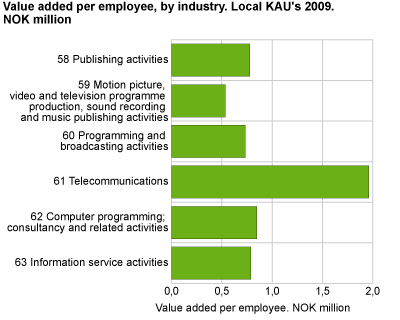Content
Published:
This is an archived release.
Decline in newspaper turnover
Turnover in the publishing of newspapers was down 7.8 per cent from 2008 to 2009, while employment was down 6 per cent from 9 823 to 9 235 persons during the period.
In the publishing sector, 314 companies were registered in 2009, which is a decline of 3.7 per cent from 2008. Turnover in the industry group was NOK 42.1 billion in 2009; a decline of 3.1 per cent from the year before. Employment was equivalent to a decrease of 3.5 per cent in the period, while value added for the group was similar to the previous year. Turnover among companies that publish newspapers fell from NOK 15.8 billion in 2008 to NOK 14.6 billion in 2009, value added declined by 10.3 per cent and the production value went down by 7.8 per cent. The other industry group in publishing; publishing software, reported a revenue growth of 5.6 per cent from the year before. Turnover increased from NOK 13 to 13.7 billion, value added was up 16.1 per cent and employment increased by 2.5 per cent to 8 237 persons.
Motion picture and movie theatres showed an increase of 13.2 per cent as sales increased from NOK 1.1 to 1.25 billion in 2009. Correspondingly, the value added for the film increased 24.3 per cent. The industry group that includes movie theatres; "Film, video and television programme production," shows in 2009 a turnover similar to the previous year of NOK 7.3 billion. This is mainly due to a decrease in the largest sub-group; "Production of film, video and television programmes”, where turnover fell by NOK 500 million.
Lower sales in radio and television
Sales in radio and television broadcasting went down by 4.2 per cent from the previous year to NOK 8.9 billion. The industry consisted of 185 companies, where employment was down 1.7 per cent from 2008 to 5 824 employees.
Telecommunication stable
The total turnover in telecommunication amounted to NOK 65.4 billion, which is roughly the same as in 2008. The number of enterprises in the industry fell by 4.5 per cent to 660, and employment declined by 3.5 per cent to 12 964 in 2009. In 2009, a significant decline in sales and employment for wireless telecommunications was recorded, and there was a corresponding increase in revenue and employment for wired telecommunications. This is due solely to economic changes, and these figures are therefore not comparable with previous years. Total revenues for the two industry groups fell only 0.3 per cent to NOK 59.1 billion. Total employment was 11 755; a decline of 4.3 per cent from the year before.
Satellite telecommunications rose in 2009. Revenue grew 16.2 per cent to NOK 4.6 billion and value added rose 16.6 per cent. Employment rose only by 5.6 per cent and the total was 546 persons.
Fewer companies in information technology services
Services related to activities include programming services, consulting and management and operation of IT systems. Turnover and employment in 2009 was at the same level as last year, but the number of enterprises in the sector fell 8.6 per cent to 7 400 in 2009.
The smallest industry in information and communications; information services, grew by 7.4 per cent to NOK 6.5 billion, and showed a growth in employment of 11.1 per cent. Special data processing, hosting and related services showed the strongest growth with a revenue increase of 17.2 per cent to NOK 3 billion.
Statistics at enterprise levelStructural business statistics for information and communication are compiled both at local KAU level and enterprise level. Figures at the enterprise level will usually deviate from figures at the local KAU level. This is due to the fact that the enterprises are registered in the industry sub-class that comprises the main part of the activity of the enterprise, and therefore may be registered in a different industry from some of the local KAUs. |
Comparability between 2008 and 2009Many enterprises and local KAUs within the industry division Information and communication (J) operate within different industries. The unit is placed in the division in which it has its main activity. If a unit changes its activity it may also have to move to a different industry. This is more common within industry division J than in most other industries. The result is that figures in one year may not necessarily be directly comparable to subsequent years. The effect of this is greater in figures for enterprises than for local KAUs. |
Tables:
- Table 1 Information and communication. Principal figures, by industry subclass. Local kind-of-activity units. 2008-2009
- Table 2 Information and communication. Principal figures, by number of persons employed and industry group. Local kind-of-activity units. 2009
- Table 3 Information and communication. Principal figures, by county. Local kind-of-activity units. 2009
- Table 4 Information and communication. Principal figures, by industry subclass. Enterprises. 2008 -2009
- Table 5 Information and communication. Principal figures, by number of persons employed and industry group. Enterprises. 2009
The statistics is now published as Business statistics.
Contact
-
Statistics Norway's Information Centre
E-mail: informasjon@ssb.no
tel.: (+47) 21 09 46 42


